
The coat of arms of Ukraine is a blue shield with a golden trident. It is colloquially known as the tryzub.

The coat of arms that serves as the official symbol of the Masovian Voivodeship, Poland, consists of a red escutcheon, that features a white (silver) eagle, with raised wings, and its head turned left. Its current version had been designed by Andrzej Heidrich, and adopted in 2006.

The coat of arms of the West Pomeranian Voivodeship, Poland depicts a red griffin with yellow (golden) beak and claws on the white (silver) background. The coat of arms was created by Jerzy Bąk and adopted in 2000.

The coat of arms, that serves as the symbol of the Opole Voivodeship, Poland, features a yellow (golden) eagle wearing a yellow (golden) crown, placed on a blue background. It was adopted in 2001.
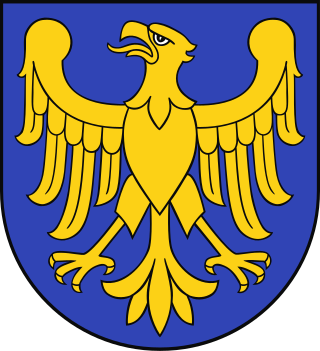
The coat of arms, that serves as the symbol of the Silesian Voivodeship, Poland, features a yellow (golden) eagle on a blue background. The current version of the coat of arms was adopted in 2001, and based on the historical coats of arms of Upper Silesia.

The flag that serves as the symbol of the historical and geographical regions of the Silesia, and Lower Silesia, and as one of the symbols of the Silesian people, is divided horizontally into two stripes: white on the top and yellow on the bottom. It originated as the flag of the Province of Silesia, used from 1882 to 1919, that later used as the flag of the Province of Lower Silesia, from 1920 to 1935. Currently, the flag is recognized symbol of the Silesian people in the state of Saxony in Germany.

The Ruthenian lion, also known as the Ukrainian lion or Galicianlion, is a golden lion on an azure background. The lion was featured on the historic coat of arms of the Kingdom of Galicia-Volhynia (Ruthenia), the Ruthenian Voivodeship and the Western Ukrainian People's Republic. During the revolutions in the Austrian Empire in 1848, it was restored as one of the national symbols of Ukrainians and the Ukrainian national liberation movement. Today it is featured on the coat of arms of the city of Lviv and its surrounding province, Lviv Oblast.

The flag is the symbol of the Subcarpathian Voivodeship, Poland.

The flag of the Lower Silesian Voivodeship, Poland, is a yellow (golden) rectangle with the left-faced black eagle, with a white (silver) crescent-shaped przepaska put across its wings, with a white (silver) cross pattée on top of it, in its middle.

The coat of arms of Lubusz Voivodeship, Poland, features an Iberian style escutcheon divided vertically onto two sides, of which, the left side has red background, with left side of a white (silver) eagle, with yellow (golden) crown, legs, a ring on its tail, and a przepaska on its wing, while the right side, has green background with two yellow (golden) six-pointed stars, placed vertically. It was established in 2000.
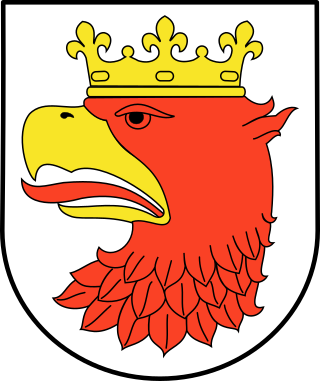
The coat of arms of the town of Police in West Pomeranian Voivodeship, Poland depicts the head of a red griffin with a yellow (golden) beak, and a yellow (golden) crown, place on the white (silver) background.

The coat of arms of the Łódź Voivodeship, Poland is an Iberian-style escutcheon with square top and rounded base. It is divided horizontally into three stripes (pales), that area from left to right: yellow (golden), red, and yellow (red), with the middle stripe being twice as big as the other stripes. It also include three charges placed in its center, with two placed next to each over, on the top of the third one. The top two charges are Kuyavian Hybrids, divided into half, into a lion and an eagle, while the bottom one is an eagle. It was designed by Marek Adamczewski, and officially adopted on 25 June 2002.

The coat of arms of the Kuyavian-Pomeranian Voivodeship, Poland, consists of a white (silver) escutcheon, with a half of an eagle facing left, joined with a half of a lion facing right, both animals together wearing a yellow (golden) crown on their joined heads. It had been adopted in 2000.

The coat of arms and flag that serve as the symbols of the Police County, in West Pomeranian Voivodeship, Poland were established on 28 June 2000. They were designed by Radosław Gaziński.

The coat of arms of the Lower Silesian Voivodeship, Poland, features a black eagle with a white (silver) crescent put across its chest and wings, with a white (silver) cross pattée on its top, placed in a yellow escutcheon (shield). The first version of the coat of arms had been adopted in 2000, and current version, in 2009.
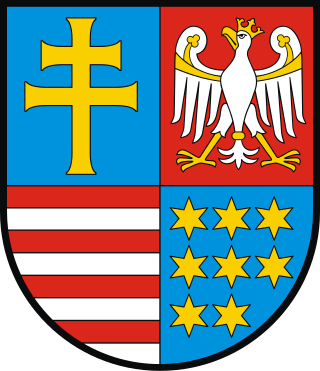
The coat of arms that serves as the symbol of the Świętokrzyskie Voivodeship, Poland, consists of the Iberian style escutcheon (shield), with square top and rounded base, that is divided in the 2 by 2 chessboard pattern. The top left field features a yellow patriarchal cross. The top right field features a white eagle with yellow crown, beak, legs, stripes on its wings, and a ring on its tail. The bottom left field features eight yellow six-pointed starts, placed in three rows, each with three stars, with the exception of the bottom row, that only had 2 stars, placed to the left.
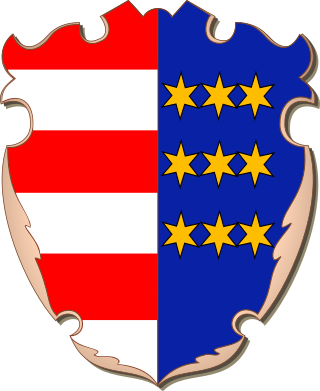
A historical coat of arms symbolized the Sandomierz Land and Sandomierz Voivodeship of the Kingdom of Poland from the 14th to 18th centuries. It was divided into two fields, with the left field consisting of six stripes, alternating either between red and white or red and yellow, and with the right field consisting of several yellow six-pointed stars, whose number varie dbetween seven and nine.

The coat of arms that serves as the symbol of Podlaskie Voivodeship, Poland is divided into two horizontal red fields. The top field depicts a white eagle, and a bottom field, a knight in a white (silver) armor, sitting on a white (silver) horse with a blue saddle and shabrack, and yellow (golden) harness, standing on its back hoofs. The knight has a blue shield with a yellow (golden) cross of Lorraine on it, put on his left arm, and hold a sword in his right hand. The current design of the coat of arms was designed by Tadeusz Gajl, and adopted in 2001.

The coat of arms of Pomerania, also known as the Pomeranian Griffin, is the symbol of Pomerania, a historical region on the southern shore of the Baltic Sea in Central Europe, split between Poland and Germany. It depicts a red griffin with yellow (golden) beak and claws, placed within a white (silver) shield. It originates from the late 12th century.
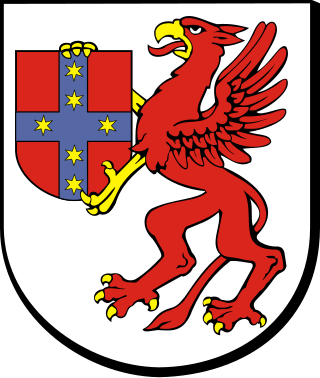
The coat of arms of Szczecinek County, West Pomeranian Voivodeship, Poland, depicts a red griffin holding a red shield with blue cross and six six-pointed stars on it, placed in a white escutcheon (shield). The flag consists of three vertical stripes, which are white, red, and white, with the middle red stripe being three times wider than the others. In its centre is placed the coat of arms. Both symbols were established on 4 November 1999.





















